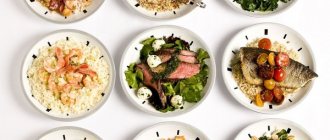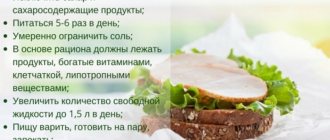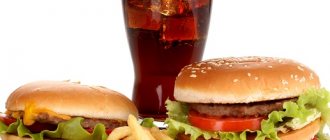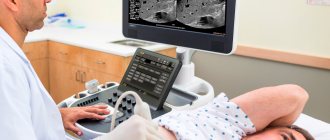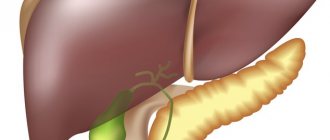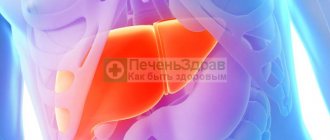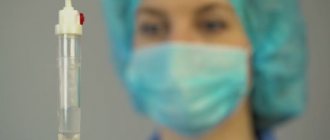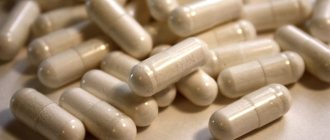4506
A diet for fatty liver hepatosis allows you to restore your health and also guarantee the normal functioning of the organ. Diet is often prescribed as an addition to primary treatment when medication is necessary.
A common cause of the disease is poor nutrition, when the body receives excessively fatty foods. Changes in the endocrine system can also lead to such a disease. Bad habits also have a detrimental effect on the organ.
General information about the liver
The liver is the largest internal human organ, which, in addition to its cleansing function, performs a lot of other duties, for example, it synthesizes one of the most important proteins - albumin. This protein binds and transports necessary substances: trace elements, hormones, bilirubin, fatty acids, gryptophane, organic anions. Liver diseases lead to disruption of albumin synthesis in sufficient quantities.
List of allowed dishes
For this disease, it is useful to include in the daily menu:
- milk, natural yoghurts, low-fat lightly salted cheeses;
- heat-treated chicken protein;
- vegetarian soups, milk stews;
- rice and buckwheat porridge;
- stewed/boiled/baked vegetables;
- steam omelette;
- non-acidic fruits, fresh, baked or boiled;
- fermented baked milk, sour cream, yogurt, kefir;
- marshmallows, mousses, marmalade, jelly, jams;
- yesterday's or dried bread;
- savory pies with meat, fish, and cottage cheese fillings;
- tea with lemon, rosehip decoction, homemade compotes and juices.
What is fatty liver disease
Fatty liver disease is a liver pathology characterized by the degeneration of healthy cells into fat bubbles. In mild stages, the symptoms are not obvious, but as the disease progresses, typical signs appear:
- bloating;
- drowsiness;
- poor appetite;
- diarrhea;
- nausea;
- weakness;
- heaviness, pain in the liver area.
Since the number of healthy cells decreases, liver function is disrupted, the level of protein synthesis decreases, which affects the functioning of other organs. In this case, the following concomitant diseases may be observed:
- Cholelithiasis.
- Diabetes.
- Hormonal imbalances.
- Cirrhosis.
- Diseases of the cardiovascular system.
The main reason for the development of fatty hepatosis is poor nutrition, so treatment primarily involves following a diet.
Answers to frequently asked questions
The diet for fatty liver is very varied, but requires strict adherence over a long period. When treating a disease, patients have many questions.
What diet is suitable for endogenous steatohepatosis?
Endogenous fatty liver hepatosis occurs against the background of metabolic diseases. To reduce the amount of fat in the parenchyma, adhere to a physiological diet. The principles of nutrition differ little from those observed within table No. 5.
How long does the diet last?
If the cause of liver dysfunction is poor nutrition, the diet is followed throughout life.
Is diet 8 according to Pevzner suitable for fatty hepatosis?
Diet No. 8 is recommended for obesity. It aims to reduce weight by reducing caloric intake. This nutritional system is suitable only for those patients with hepatosis whose body weight exceeds the norm by 20% or more.
What happens if you don't follow a diet?
Failure to comply with the diet is dangerous due to complications - cholecystitis, cirrhosis, atherosclerosis, hypertension. Refusal of a balanced diet during pregnancy is fraught with complicated childbirth and fetal hypoxia.
The diet is aimed at reducing the concentration of fats in the liver and stimulating its functions. Refusal of diet therapy leads to complications, many of which can only be treated with surgery. If the patient does not adhere to a balanced diet after surgery, this will lead to dangerous consequences.
Against the background of diabetes, obesity, alcohol abuse and other disorders, lipids can accumulate in excess in hepatocytes, which in medicine is called fatty infiltration, hepatosis or steatosis. The progression of the disease does not exclude the development of cirrhosis and even oncology. The chances of recovery increase if, in addition to taking medications, the nutritional diet is adjusted. A diet for fatty liver hepatosis helps to restore it, and a sample menu for the week can be agreed upon with a competent specialist.
Dietary needs
Therapeutic dietary nutrition can independently restore the liver only with minor lesions. In more severe cases, this can only be achieved through complex therapy, which consists of a course of medications, diet, and elimination of bad habits.
The diet is extremely useful for cholelithiasis, cholecystitis, and hepatitis. It is also recommended to follow a certain diet after gallbladder resection.
Some dietary restrictions also have a positive effect on other pathologies, for example, during seasonal exacerbations of allergies. In this case, liver function is normalized and activated, reactions appear with much less intensity.
It is important to know! Following a diet helps reduce excess weight by about 5 kilograms within a month without negative effects on health.
Why you need to diet
Proper nutrition is the key to health, and not only for hepatosis. Many diseases develop due to the abuse of foods with harmful additives, large amounts of sugar, alcohol, and so on.
Of course, you can pamper yourself with anything from time to time, but you need to remember that the body is a fragile system that needs vitamins and nutrients from different food groups.
https://youtube.com/watch?v=Uhs6FRYJgY4
Hepatosis is the initial stage of adverse changes in the liver, which subsequently contributes to the development of cirrhosis.
If there are diseases in other organs of the gastrointestinal tract, pathologies such as:
- cholecystitis;
- diabetes;
- gallstones;
- gastritis;
- cancerous tumors.
Patients who have liver steatosis and liver hepatosis and do not plan to follow a diet are at risk of developing many unpleasant consequences. The disease often provokes chronic cholecystitis, during which stones form in the gall bladder, cirrhosis and diabetes mellitus.
In addition, hepatosis is sometimes complicated by vascular diseases, such as varicose veins or high blood pressure.
Often, against the background of fatty degeneration, atherosclerosis, chronic diseases of the gastrointestinal tract and cancers in the reproductive system appear. In addition, fatty liver causes a constant decrease in immunity, which is fraught with an increased risk of developing infectious diseases.
What is the Table No. 5 diet?
Dietary table No. 5 is able to completely replace the amount of proteins that a damaged liver cannot synthesize. And the organ itself is not subject to additional stress at this time.
With a properly designed daily diet, the following parameters must be observed:
- protein - 120 g;
- about 300 g carbohydrates;
- fats – 80 g;
- 2 liters of water;
- salt – 6 g.
The diet is frequent (about 6 times) and in small portions. The last meal is taken 2 hours before bedtime. When served, dishes should be only slightly warmed up; foods from the refrigerator and hot food should be excluded. It is recommended to steam, boil, and bake food. All fried foods fall under the “prohibited” category.
The amount of food at one time should not lead to overeating. A full stomach puts unnecessary stress on the liver. It is allowed to increase the dose of food only in case of exhaustion of the body.
https://youtu.be/QzJK2-nhtWU
Principles of diet planning
Animal proteins should make up about 70% of the daily requirement. They reduce the time it takes to restore liver function. Thus, as a result of medical research, it became known that the greatest amount of protein is found in meat and dairy products. It has been experimentally established that when 0.4 kg of cottage cheese is introduced into the diet during the day, patients with hepatitis recover much faster.
Unlike proteins, fats are recommended to be taken in the form of vegetable oils, which contain unsaturated fatty acids. Small portions of butter are allowed as animal fats, but without high-temperature treatment.
Healthy carbohydrates give the body strength and energy, which is important during physical labor. The main sources are vegetables and fruits. Also, these foods contain a sufficient amount of fiber, which helps eliminate excess cholesterol.
The daily amount of fluid is individual for each patient and depends on possible concomitant pathologies. For example, with cirrhosis, water restriction is recommended, and with a healthy urinary system, you can increase water intake to two and a half liters. The daily amount of salt also depends on these factors. With some fluid retention (tendency to edema), it is necessary to reduce the amount of salt to 4 g per day.
When compiling a diet, one should not forget about the required level of vitamins and minerals - riboflavin, lecithin, nicotinic acid, inositol, choline, vit. groups C, V.
Squirrels
https://youtu.be/e1fHMxDYyNo
In case of fatty hepatosis, the daily amount of protein obtained from food should remain within the physiological norm of the patient (about 1 g/kg of weight). Half of it comes from plant foods, and the remaining 50% comes from animal foods.
They are found in:
- poultry (chicken, chickens, turkey without skin are allowed);
- animal meat (veal, beef, rabbit are acceptable);
- fish;
- dairy products (low-fat cheeses, cottage cheese, low-fat kefir, etc.);
- eggs;
- buckwheat;
- soy flour;
- oatmeal.
If you start limiting proteins, then their deficiency can only increase liver fatty degeneration. Sometimes it is detected in completely debilitated patients.
Authorized Products
So, what foods are included in the therapeutic diet for fatty hepatosis, table No. 5. You should not think that if a patient is prescribed a proper diet, he will starve. As a rule, dietary table No. 5 includes a sufficient list of ingredients for preparing healthy dishes:
- Poultry – turkey meat, lean chicken. When cooking, remove fat and skin.
- One hard-boiled egg, unlimited number of whites.
- Dairy products - milk, low-fat cottage cheese.
- Seafood – low-fat fish, black caviar.
- Meat without fat, tendons, cartilage.
- Rye bread, yesterday's wheat bread, crackers, dry cookies. The consumption of baked goods is limited in case of obesity, and baked goods are excluded.
- Vegetables, greens - absolutely all types are allowed, with the exception of sauerkraut; in case of gastrointestinal pathologies, fresh white cabbage is also not allowed.
- Cereals – porridges should be cooked in water; it is allowed to make puddings from cereals and steam them.
- Consumption of pasta within reasonable limits is allowed. If you are obese, they should be excluded.
- Dishes can be seasoned with spices - bay leaf, parsley or dill, coriander. It is recommended to limit the amount of cloves, vanilla, and cinnamon.
- Drinks that will help replenish your water balance - weak coffee, fresh juices, rosehip infusion, weak tea.
- As dessert, marshmallows, non-acidic berries, honey, fruits, white sugar are used, but in moderation.
Advice! It is recommended to discuss the preparation of a diet with your doctor, who, based on the diagnosis and concomitant diseases, can adjust the diet and give advice on dishes and the amount of food.
What you can and cannot eat with liver steatosis
A balanced diet for fatty liver reduces the load on the hepatobiliary system. Within the framework of diet therapy, products are divided into two groups:
- allowed - reduce cholesterol in the body, stimulate lipid metabolism;
- prohibited - increase the concentration of fats in hepatocytes, disrupt the functioning of the gastrointestinal tract.
Table 5 is the optimal nutrition system for patients with hepatosis. When following a diet, the level of triglycerides in the liver parenchyma decreases by 15-25%.
Table of permitted products
To maximize sparing of the gastrointestinal tract, the menu includes products that restore the activity of the intestines and liver. They should contain:
- cellulose;
- choline;
- B vitamins;
- methionine;
- lipoic acid.
Products with lipotropic properties stimulate the biosynthesis of lecithin, thereby accelerating the removal of fatty deposits from the liver.
What can you eat if you have fatty liver disease?
| Product groups | Product examples |
| fruits | apples, watermelon, pomegranates, bananas, peaches |
| dairy | low-fat milk, unsalted hard cheese, yogurt without fillers, sour cream |
| bakery | dry biscuit, rye bread |
| cereals | oatmeal, buckwheat, rice (with milk), semolina |
| vegetables | beets, carrots, potatoes, green peas, cauliflower, fresh salad |
| gas station | vegetable oils |
| meat | chicken fillet, dietary veal, turkey, rabbit |
| seafood | salmon, pollock, tuna, shrimp |
| Dessert | fruit jam, cottage cheese casserole, protein mousses, marshmallows, biscuits |
| beverages | decoction of chamomile and rosehip, compotes, jelly, smoothies, weak coffee, fruit juices without sugar |
| other products | squash caviar, pumpkin seeds, meat puree, vinaigrette, dried fruits, vegetarian cabbage soup |
If more than 60% of the liver is affected, dishes with vegetables and meat are consumed chopped.
Table of prohibited products
Eating refractory lipids, purines and carbohydrates disrupts digestion. To reduce the load on the liver, it is necessary to exclude foods that irritate the gastrointestinal tract and increase the secretion of gastric juice.
What not to do for fatty liver:
| Product groups | Product examples |
| fruits | figs, grapes, unripe plums, wild berries, cherries, melon, raspberries |
| dairy products | country milk, full-fat sour cream, fermented baked milk, cottage cheese, yogurt with fillings |
| bakery | yeast dough, fresh biscuit and bread |
| vegetables | rhubarb, onion, white cabbage, asparagus, eggplant, spinach, dill, radish |
| cereals | wheat, barley, corn |
| gas station | mayonnaise, tomato, adjika, horseradish dressing, ketchup |
| meat | canned fish, duck, lamb, smoked meat, pork |
| seafood | trout, sturgeon, octopus, oysters, burbot |
| Dessert | chocolate, cakes, donuts with pastry cream |
| beverages | alcohol, sweet soda, cocoa, coffee |
| other products | sunflower seeds, sausages, boiled eggs, canned food |
When following a diet, you should limit the amount of sugar and honey. Carbohydrates quickly transform into fats, which causes liver condition to worsen.
Prohibited Products
In order not to aggravate the patient’s already unsatisfactory condition, when preparing diet No. 5, you should remember about foods prohibited during diagnosis. As a rule, the main prohibition concerns fried, smoked and salted foods, fast food and alcohol. In addition, you need to remove from your diet during the food restriction:
- Onions, horseradish, radishes, spinach.
- Desserts containing chocolate.
- Salmon, trout.
- Bananas.
- Duck, goose.
- Cream, sour cream.
- Lamb, pork.
Vegetable broths can be varied with pasta. Salads are seasoned with vegetable oils.
What foods should you exclude from your diet?
Following a diet for hepatosis is the key to recovery!
People suffering from fatty liver disease should completely exclude the following foods and dishes from their diet:
- rich meat broths;
- onions and garlic;
- fat meat;
- peas and beans;
- pickled products;
- tomatoes, radishes;
- milk, sour cream, cottage cheese;
- sweet carbonated drinks, strong coffee.
https://youtu.be/GPCF5UJ-XUo
Diet recipes
The extensive list of foods allowed during the diet and culinary ingenuity make it possible to prepare quite a lot of dishes. Purees, soups and desserts allow a person to eat properly, without feeling deprived of the right to eat what they want.
It is important to know! Diet for fatty liver hepatosis table 5 makes it possible to use various tasty and healthy recipes.
Soups
For lunch there should be a liquid dish, that is, soup. From permitted products you can make beetroot soup, vegetable broth with meatballs, soup with potatoes and pasta. To prepare beetroot soup in a 5-liter saucepan you will need:
- potatoes - 10 small tubers;
- 1 onion;
- beets – 4 medium size;
- half a fresh cucumber;
- dill;
- Hard boiled egg;
- pieces of lean meat.
Cook the beets and onions whole. Remove the boiled vegetables from the broth and add chopped potatoes. When the potatoes are ready, add the grated root vegetable to the soup. Before adding beets to the soup, it is recommended to sprinkle them with a little lemon juice and let them sit for a while. When the beetroot boils, season it with sugar and salt. Before serving, chop a hard-boiled egg, fresh cucumber, boiled meat into a plate, add warm beet soup.
Second
Mashed potatoes, stews, porridges, cabbage rolls, boiled potatoes, egg white omelettes, meat with vegetables, and salads are good options for a second course. For example, you can make chicken meatballs with any side dish. Recipe:
- chicken breast – 1 kg;
- half a glass of rice;
- 1 onion;
- white of one egg;
- Bay leaf;
- salt.
Grind the meat in a meat grinder. Bring the washed rice to a boil, drain the water. When the rice has cooled, mix it with minced meat, egg white and salt. Form dense balls from the resulting mixture and place them in a pan. Add the peeled whole onion here. Pour boiling water over the contents of the dish and bring to a boil under a closed lid. If desired, add bay leaf and cook the meatballs for about another hour. This dish goes well with vegetable salads and mashed potatoes.
Dessert
A patient on a diet does not lose the pleasure of eating sweet foods, but the type of desserts changes. Instead of cakes and pastries for hepatosis, options such as cottage cheese casserole, cheesecakes, apple pie, fruit soufflé, and other equally appetizing dishes are offered.
Any patient will be pleased with baked cheesecakes:
- a little flour;
- half a kilogram of low-fat cottage cheese;
- butter;
- egg white.
Rub the cottage cheese through a fine sieve, mix with one egg white, knead well. Form small cakes from the resulting mass and cover with flour. Place the cheesecakes on a baking sheet and bake in the oven. Serve the dish with fruit, honey, and fresh berries.
Why do you need a diet?
A fundamental element of treatment is a change in lifestyle, which includes proper nutrition. The patient’s diet should be monitored by the attending physician, who will take into account the physiological characteristics of the body and the stage of development of the disease. A properly selected diet for liver hepatosis has the following positive effects:
- restoration of normal liver function;
- stabilization of fat metabolism in the body;
- lowering blood cholesterol levels;
- normalization of glucose levels;
- stabilization of bile production.
General recommendations
Overeating and starvation are equally dangerous with steatohepatitis. Therefore, despite the need to lose weight, the diet must contain sufficient nutrients.
The diet does not provoke the opposite effect and exacerbation.
Treatment of fatty liver hepatosis is a long process, during which the patient must follow the following basic recommendations from doctors:
- Small meals are recommended 5-6 times a day with short breaks. Portions should be small to prevent overeating and fat gain.
- Doctors recommend following diet number 5.
- The diet for fatty liver excludes hot and cold foods. The optimal food temperature is 20-60 °C.
- You should drink about 2 liters of still water.
- Protein norm - 100 g/day, animal fat - 70 g/day.
- Dishes for hepatosis should not contain purines and cholesterol.
- It is necessary to reduce salt and sugar intake to a minimum.
- You should eat foods that are rich in pectin and fiber: apples, pears, carrots, dill, cilantro.
- If there is a deficiency of micro- and macroelements, dietary supplements should be added to the diet, but only after consulting a doctor.
Sample menu for the week
The menu for fatty liver disease, diet No. 5, for a week is compiled by specialists, but you can also use nutritionist’s templates as a basis.
| Day of the week | Breakfast | II breakfast | Dinner | Dinner | II dinner |
| Monday | Curd casserole with berries | Peach juice | Rice porridge, vegetables, shrimp | Carrot salad | Rose hip decoction |
| Tuesday | Oatmeal | Cranberry juice | Vegetable soup, fish | Salad (cucumbers, tomatoes) | One apple |
| Wednesday | Fruit salad | Ryazhenka | Beetroot | Chicken, zucchini | Chamomile decoction |
| Thursday | Semolina | Kefir | Chicken soup, vegetable stew | Fish, stewed cabbage | Avocado |
| Friday | Boiled egg | Weak tea | Beef cutlets, buckwheat | Sea kale | Chamomile decoction, marshmallow |
| Saturday | Cottage cheese, fruit | Juice from fresh apricots | Rice, vegetables, turkey | Boiled egg | Paste |
| Sunday | Semolina | Rose hip decoction | Fish, broccoli | Pumpkin puree | One apple |
When drawing up diet menu No. 5 for the week, you should take into account the patient’s gender, age, concomitant diseases and, of course, taste preferences.
Men are recommended to include a sufficient amount of meat dishes in their diet to maintain physical fitness, which will also be beneficial for the growing body of adolescents. Women prefer food that allows them to maintain an ideal figure; for this, fish and fruits should predominate in their diet.
Principles of table No. 5
A diet for treating the liver with fatty hepatosis involves following table No. 5. Nutrition recommendations were developed by a major Soviet nutritionist, M. Pevzner.
The main principle of table No. 5 is the balance of products. The approximate ratio of proteins, fats, carbohydrates and salt (g) is presented in the diagram.
Salt intake should be limited to 10 g/24 hours.
What should you eat?
The basis of the diet for hepatomegaly and fatty hepatosis are dietary varieties of meat and fish. You should also saturate your diet with low-fat milk, vegetables and cereals.
Table 2. What to include in the menu for liver hepatosis?
| Product | Description | Daily serving (g) |
Vegetable oils. | It is recommended to give preference to corn oil. You can alternate it with high-quality olive oil. | 45 |
Bran. | It is advisable to eat wheat bran. They should be used when preparing low-fat and non-rich porridges. | 30-50 |
Vegetables. | The emphasis should be on eating fresh vegetables. You can also prepare vegetable soups and stews. | 150-200 |
Greenery. | Preference should be given to rhubarb and lettuce. | 50-70 |
Fruits and berries | They are recommended for use in the preparation of fruit and berry soups, mousses, and juices. | 150-250 |
Cereals | For hepatosis, it is recommended to focus on buckwheat and rolled oats. You can cook porridge from these cereals and add them to soups. | 100-200 |
Seafood in the photo | You can eat shrimp, brine, mussels. It is best to use them when preparing soups. You need to prepare soups according to the instructions - they should not be fatty or rich. | 150 |
Milk products | Milk soups and low-fat casseroles are very useful. | 120-250 |
Eggs | For hepatosis, it is recommended to eat egg yolk. You can also make a steam omelet from eggs. | 1-2 pieces. |
Note! It is strictly not recommended to eat store-bought chicken. It contains traces of hormones and antibiotic drugs, which contributes to liver overload.
What should you give up?
The plate lists foods that are not included in the diet for liver steatohepatosis.
Table 3. What can't you eat?
| Product | Description |
Alcohol. | It is necessary to give up both vodka and “light” alcoholic products, including “harmless” cocktails. |
Drinks with caffeine. | The therapeutic nutrition menu for fatty liver hepatosis excludes the consumption of strong black tea, coffee, and cocoa. |
Fat meat. | You should not eat pork, lamb, or beef. It is not recommended to drink broths based on such meat. |
Fatty fish. | The diet menu does not include beluga, catfish, or sturgeon. |
White bread. | Crackers made from it are especially not recommended. |
Delicious baked goods. | It is oversaturated with “harmful” carbohydrates. You cannot eat pies, pancakes and fatty cakes. |
Strong irritants. | Spicy seasonings, garlic, onions, and chili peppers are not recommended. |
Concentrates | It is important to avoid flavor enhancers, bouillon cubes, instant noodles and purees. |
Partially limited products
- cereals: pearl barley, corn, barley;
- pasta (durum wheat);
- heat-treated white cabbage;
- chicken egg (no more than 2 boiled whites per day);
- banana (no more than one per day);
- biscuit without additives (small piece per day);
- non-chocolate gingerbread – 1 per day;
- salt – up to 10 g per day;
- fresh salads from permitted vegetables in strictly limited quantities;
- butter up to 30 g per day;
- Vegetable oil for hepatosis is allowed up to 15 g as an additive to dishes;
- watermelon – 2 pieces per day;
- bell pepper;
- kefir, milk, low-fat cottage cheese - no more than 200 g per day;
- low fat feta cheese;
- lean fish is allowed no more than three times a week;
- dumplings with chicken or veal.
Causes of fatty liver
Although modern experts cannot name the exact cause of the disease, they say that the development and occurrence of the disease is influenced by a number of factors, including:
- Excess weight;
- Lack of protein in the body;
- Diseases associated with the endocrine system;
- Diabetes mellitus type II. Statistics indicate that hepatosis most often affects elderly people with hyperlipidemia and metabolic syndrome disorders;
- Presence of gastrointestinal diseases. Fatty liver is often accompanied by pancreatitis;
- Rapid weight loss. With accelerated weight loss, the liver does not have time to remove fat cells and some of them, without having time to oxidize, are deposited on the liver;
- Hormonal therapy;
- Excessive alcohol consumption.
A doctor will help you find out more precisely the cause of the disease.
Weekly diet
If you structure your diet correctly, your diet will become tasty and varied:
- Monday: vinaigrette seasoned with vegetable oil and 100 g of boiled or steamed beef for breakfast. Beef can be replaced with boiled chicken breast. Second breakfast - low-fat cheese. Lunch - okroshka with low-fat kefir, second course - boiled and grated beets with the addition of a minimal amount of salt. You can wash down your lunch with a rosehip-based decoction or weak tea. Dinner - vegetable cabbage rolls or boiled beef tongue. Green tea, without sugar. To make it sweeter, you can add honey.
- Tuesday: for breakfast - fresh cucumber and 100 g of boiled lean meat, weak coffee. Second breakfast - low-fat cottage cheese, serving size - no more than 200 g, a glass of compote. Lunch - vegetable soup without adding potatoes. The second dish is stewed cabbage, 100 g of boiled chicken without skin, compote or jelly. Dinner - boiled fish with boiled vegetables, fruit puree from non-acidic fruits. To wash down your dinner, you can prepare a rosehip-based decoction with honey.
- Wednesday: an omelet from one egg (milk with a minimum percentage of fat content is added to the omelet), a salad of permitted vegetables with vegetable oil dressing, weak coffee or tea, no added sugar. Second breakfast - low-fat cottage cheese. Lunch - beetroot soup, for the main course - baked fish with vegetables, a glass of tomato juice diluted with water. Dinner - steamed chicken with vegetables, compote.
- Thursday: it is recommended to make this day of the week a fasting day for the liver. On Thursday it is better to refrain from eating any food. You can use low-fat kefir and water. You need to drink at least 1.5–2 liters of water. Having 1 fasting day a week will help take the load off the liver, which will speed up the process of its recovery. This measure will be especially useful for those people who have a concomitant diagnosis of hepatitis.
- Friday: oatmeal with water, 1 boiled egg, cocoa for breakfast. Second breakfast - a slice of yesterday's or rye bread, a glass of low-fat kefir or yogurt. Lunch - lean borscht, as a second course - steamed chicken cutlets with boiled beets, as a sweet - green apples baked with honey and low-fat cottage cheese, a glass of water or compote. Dinner - zucchini caviar, 100 g of boiled beef, herbal decoction. Just before bed, you can drink a glass of low-fat kefir.
- Saturday: Breakfast may consist of beet puree and boiled tongue. You can drink weak coffee diluted with low-fat milk. Second breakfast - low-fat cottage cheese or baked fruit. Lunch - vegetable puree soup, boiled chicken with baked vegetables, compote. Dinner - steamed fish, vegetable salad, slice of cheese, compote or jelly.
- Sunday: vegetable salad with vegetable oil, boiled meat without side dish. Second breakfast - a slice of low-fat cheese. Lunch - vegetable soup, cabbage rolls with porridge, for dessert - yogurt or cottage cheese with fruit, a glass of weak tea without sugar. Dinner - fish with vegetables, dried fruit compote. Before going to bed, you can drink a glass of kefir, yogurt or yogurt.
During the day it is necessary to maintain the correct drinking regime. If a person has problems with excess weight in addition to fatty liver, it is recommended to drink a glass of plain water half an hour before the main meal. This measure will help you feel full faster and, accordingly, eat less.
Diagnostics
Upon examination and palpation by a doctor, the liver was not enlarged, without any features. Only when a large amount of fat accumulates can the liver become enlarged with soft, rounded edges and painful to the touch. In the early stages of fatty hepatosis, pronounced symptoms are usually not detected. In patients with diabetes mellitus due to hepatosis.
The list of necessary measures to make an accurate diagnosis includes:
- Ultrasound of the liver. Traditionally, an ultrasound examination of the liver helps to detect its enlargement, and this almost always indicates problems with the organ.
- Tomographic research. MRI allows you to evaluate the structure of the liver. If fat is deposited in an organ, this will be visible on an MRI.
- Blood chemistry. ALT and AST indicators are assessed. When they increase, we are talking about liver disease.
- Biopsy. It doesn't happen that often. Allows you to find out whether fat is present in the structure of the organ.
Recommended Diet
Gentle nutrition for such a disease is based on the following rules:
- regulation and normalization of all functions of the affected organ;
- restoration and normalization of fat metabolism;
- stimulating the secretion of bile, which plays an important role in the digestion process.
Often with this disease, patients are shown diet table No. 5. The general characteristics of such therapeutic nutrition include:
- the calorie content of consumed dishes should not exceed three thousand kilocalories;
- carbohydrates – no more than 400 grams, a quarter of which must necessarily belong to the easily digestible group;
- fats - no more than eighty grams, half of them are vegetable;
- proteins - approximately one hundred and fifty grams, more than half should be of animal origin;
- temperature regime of dishes – food consumption only at room temperature is shown;
- salt - no more than ten grams;
- liquid - at least 1.5 liters.
The indicated figures were calculated by gastroenterologists for one day.
In addition, the diet provides for the exclusion of fatty and spicy foods, as well as alcoholic beverages. Patients are recommended to eat meals in small portions; it is best to eat at the same time every day.
Nutrition rationally prepared by gastroenterologists and nutritionists for such a disorder makes it possible not only to stop the inhibition of the pathological process, but is also aimed at restoring the affected liver tissue.
Diet menu for patients with fatty liver
The weekly menu for patients with fatty liver disease must include dietary dishes rich in proteins, fats and carbohydrates.
Depending on the lifestyle, the treatment table for a patient with fatty hepatosis should be at least 1200-1500 kcal and no more than 3000-3500 kcal.
An approximate daily menu for a patient might look like this:
Breakfast: Weak tea with lemon, whites of two boiled eggs, low-fat cottage cheese.
Second breakfast Apple, dry biscuits, compote.
Lunch A piece of boiled chicken with potatoes, a slice of rye bread, a glass of kefir or milk.
Afternoon snack Low-fat yogurt (250 g), fruit or dried fruit.
Dinner Buckwheat porridge with vegetables, boiled fish (100 g), jelly.
Second dinner Banana, yogurt.
Prevention
If you want to avoid the occurrence of this disease, it is very important to follow preventive measures. What will be relevant in this case?
- Proper nutrition.
- Maintaining normal weight.
- You need to lead an active lifestyle. Walking in the fresh air is very important, as well as moderate physical activity on the body.
- You need to drink at least two liters of water per day.
- You also need to give up bad habits. Especially from drinking alcohol.
- It is important to monitor your blood sugar levels.
Fatty liver disease is a reversible liver disease. This pathology can be successfully treated in the early stages. There is no specific treatment. It all comes down to changing your lifestyle, reviewing your diet, and eliminating etiological (causal) factors.
What can you eat?
The diet for fatty liver allows for breakfast, lunch and dinner dishes prepared exclusively by steaming or decoction. If you are a fan of fried meat or fish, then you should get into the habit of baking these products.
Products high in lipotropic substances such as choline, methionine, inositol, betoin and lipoic acid are allowed and even recommended. Fat-dissolving substances help stimulate the synthesis of lecithin in the liver and remove fat from the organ.
What can you eat in small doses? The consumption of energizing drinks and sodas is provided. It is also possible to use low-fat sour cream in dishes.
For lunch you can enjoy dishes made from vegetables and cereals such as cabbage soup, borscht and milk soup. For the second course, if you have hepatosis, boiled vegetables are recommended as a side dish. In this case, cabbage, boiled onions and carrots have especially healing properties. Since the patient has to eat often, but not a lot, it is advisable to consume boiled fresh vegetables in salads.
For liver hepatosis, the diet includes the consumption of the following products:
- sunflower and pumpkin seeds without abuse,
- weak herbal teas with lemon, preferably without sugar, fruit and berry juices without sugar, compotes, mousses, jellies,
- boiled pasta,
- a limited list of seafood and fish, when purchasing which you need to be vigilant,
- oatmeal cookies, crackers, rye bread,
- kefir, curdled milk, milk. It is important that the fat content does not exceed two percent,
- boiled beets, pumpkin, zucchini, Chinese cabbage,
- baked apples, pomegranate,
- butter,
- sweet berries, dried fruits, jelly, not very sweet jam, honey, marshmallows.
An approximate menu for a week for this disease should consist of regular and satisfying portions. So, table No. 8 according to Povzner is the following diet:
- beginning of the day: first breakfast - oatmeal cooked in water, low-fat cottage cheese, for the second snack - a vegetable snack or steamed omelet.
- lunch: vegetable broth soup, vegetables and fish balls, also steamed,
- dinner: vegetable casserole, vegetable salad, a small portion of boiled dietary meat,
- towards the end of the day: herbal tea or kefir.
The next day, low-fat yogurt and weak herbal tea are perfect for breakfast, and baked fish along with mashed potatoes will be a hearty and tasty lunch. By noon, a glass of diluted fruit juice and low-fat cottage cheese will be preferable.
For dinner on this day you can have a small portion of cauliflower soup, which must be accompanied by a teaspoon of low-fat sour cream. Before going to bed, you can eat bread or crackers.
Reviews
Karina, 42 years old, Vologda: “The transition to a diet after the diagnosis was difficult for me. Those who are used to eating mayonnaise and sausages every day will understand me. As a result, I managed only with the help of a nutritionist, who compiled the necessary menu. After a month, I completely got into the diet and no longer experienced any difficulties. I realized that this kind of food, healthy and without fatty sauces, can be delicious.”
Andrey, 52 years old, Murmansk: “I refused to diet for a long time, until the doctor said that my tests were extremely bad and that I might need surgery, after which I would need a diet. The food is normal, even tasty, with different dishes. I've been on this diet for 2 years now. My health has become good, I forgot that I have fatty liver. There were no relapses for 2 years.”
https://youtu.be/NWEMR-GNvLg
Mikhail, 55 years old, Novgorod: “For a long time I wondered how one diet could cure liver disease. But from my own example I realized that it is possible. The beginning of the diet was difficult, I didn’t eat enough, I constantly wanted fatty meat, but after 2 weeks I got into it. Tests and ultrasounds done a few months later showed that the condition of the liver had improved. Friends note that even in appearance I began to look younger and fresher.”

